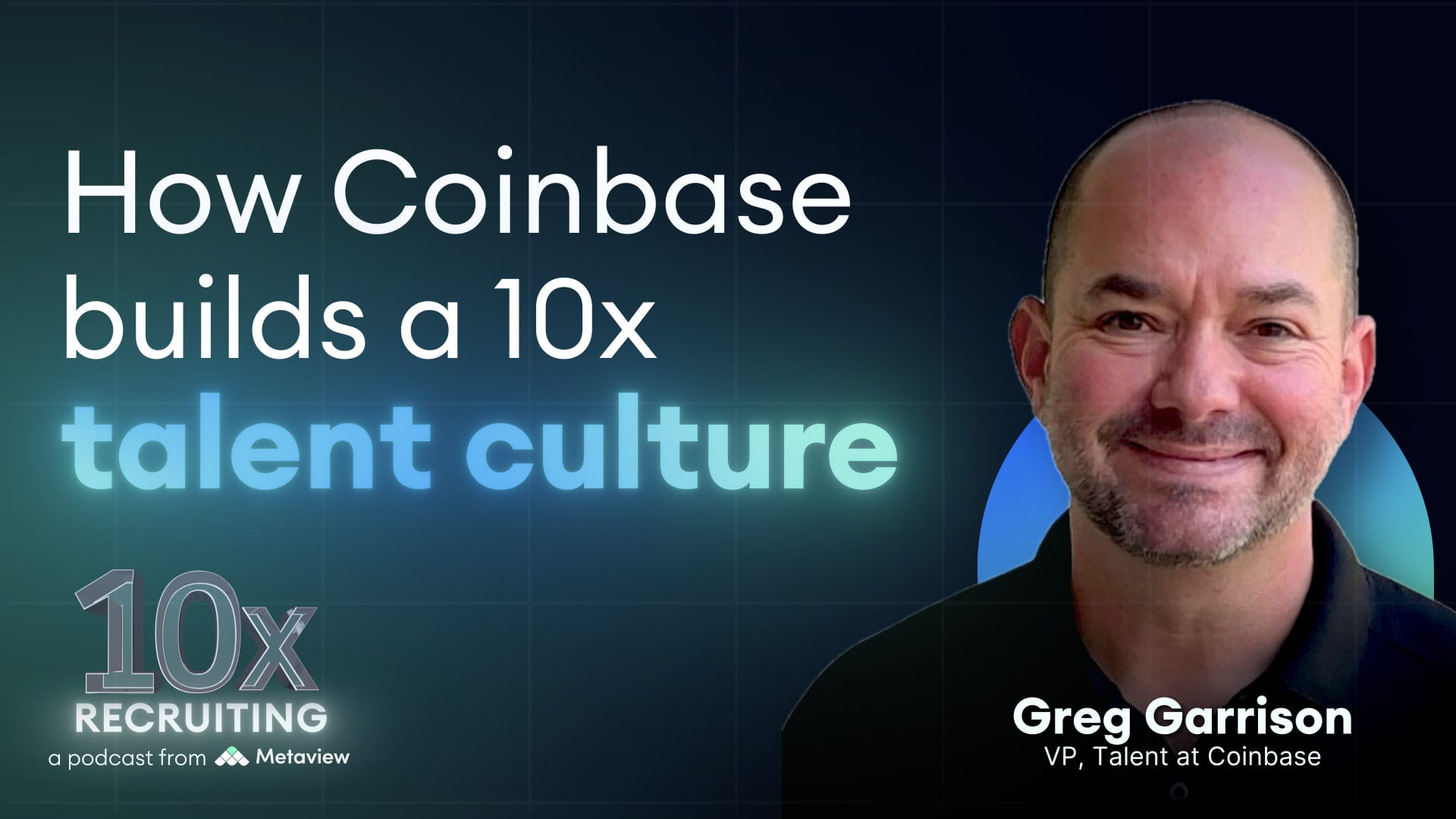What does it take to get “top talent in every seat? cGreg shares how he spots top recruiters (hint: look for a competitive drive), why every Coinbase hire goes through CEO review, and how they build a hiring culture that’s always in service of talent density. From Olympic athletes to competitive ballroom dancers, Greg looks for recruiters with the will to win — and builds systems that bring out their best.
Listen, like, and subscribe on:
Or wherever you get your podcasts!
Key takeaways:
- Talent density starts at the top: Without CEO and President-level buy-in, raising the talent bar isn’t sustainable. Coinbase’s leadership reviews every offer — forcing higher standards across recruiting and hiring.
- Great recruiters are built on drive, not just experience: Greg looks for signs of grit — agency backgrounds, competitive histories, and a relentless will to win — more than polished resumes.
- Hiring as a science is a long game: Coinbase uses assessments not as pass/fail gates, but to collect data that will make hiring smarter over years — not weeks.
"You get out of it what you put into it. If you're taking up a seat while I’m trying to find the next Michael Jordan to join the team, you need to earn that seat." — Greg Garrison
In this episode of 10x Recruiting, Nolan Church sits down with Greg Garrison, VP of Talent at Coinbase and the architect behind Google’s legendary Austin recruiting operation. Greg shares the inside story of how he built one of tech’s most productive talent acquisition teams from the ground up — hiring over 1,000 recruiters, sourcers, and coordinators at Google while maintaining a top-tier talent bar.
This conversation dives into what drives exceptional recruiters, how Coinbase’s pioneering take on talent density is reshaping industry standards, and why talent quality always starts at the top. From scaling massive recruiting teams at Google to shaping talent practices at Coinbase, Greg offers a blueprint for recruiting excellence in an increasingly competitive talent market.
How to scale a recruiting team without sacrificing quality
When Google made the decision to centralize its North American recruiting operations, they tasked Greg with a seemingly impossible challenge: hire 100 recruiters in 90 days.
The logic goes that scaling quickly probably means compromising on quality. But Greg’s mandate was clear: He had to build a team that not only scaled rapidly but also matched or exceeded the productivity of established recruiting operations.
"The bar had to be high," Greg recalls. "It wasn’t just about launching the site and hiring 100 recruiters. It would’ve all been for naught unless the productivity per resource was equal to or better than the other recruiting operations."
This directive forced Greg to rethink the traditional approach to scaling. Instead of relying on quick fixes or lowering standards, he focused on building the right foundation first.
"The first thing I did is recruit internally," Greg explains. "So I started looking around — who were the best of the best already at Google? Or who on my bench would I want to bring with me?
By starting with a small group of top-performing leaders, Greg created a core team of high achievers. These leaders, in turn, had a multiplier effect, unlocking rapid growth while maintaining the same high standards. It’s a reminder that great recruiting starts with great recruiters — and it all begins with leadership.
The mental model for spotting elite recruiters
After hiring thousands of recruiters across his career, Greg has developed a clear understanding of what separates extraordinary recruiters from average ones. His data-backed approach centers around three key attributes:
College education
Greg emphasizes that, while it’s not about where someone went to school, a degree is an important signal. "I want you to have a degree," Greg says. "It doesn’t matter if you went to Harvard or a state school, but we saw top-right separation in our data." This sets a baseline for a candidate’s work ethic and intellectual capacity — important indicators for a successful recruiter.
Agency recruiting experience
Greg values candidates who have worked in agency recruiting. "Agencies invest heavily in teaching people how to recruit," he explains. The fast-paced, commission-based nature of agency work builds resilience and hustle, traits that translate well to in-house roles. Greg particularly values candidates who have spent time in environments where performance is closely tied to effort and results.
Competitive background
The third trait Greg looks for is a competitive spirit. "I love to hire recruiters who grew up in a competitive environment," he says. "It’s the will to win. I want someone with a strong drive to succeed." This competitive streak is a clear differentiator between recruiters who thrive and those who are just surviving. Greg has hired Olympic athletes, collegiate competitors, and even a ballroom dancer who became one of his best recruiters.
This competitive drive is what separates the “thrivers” — those who consistently outperform — from the “drivers” (solid performers who hit their goals) and “survivors” (those who struggle to keep up). By hiring people with a deep-seated desire to win, Greg finds the edge needed to scale successfully.
The leaderboard strategy that drives performance
In building Google’s Austin operation, Greg introduced a cultural artifact that became a hallmark of the team: the weekly leaderboard.
"We would post the top 25% of recruiters outside my office every Monday morning," Greg recalls. "There were two types of recruiters: some who never checked it, and others who waited outside my door to see if they made the list."
This simple tool helped identify and nurture top performers, creating an environment where excellence was visible and celebrated. However, Greg quickly realized the potential downside of this approach: "I used to print the whole list, but then I realized I didn’t want to shame people. It really stinks if you're in the bottom decile."
Instead of focusing on failure, Greg refined the process to spotlight success and keep morale high. By making the leaderboard an aspirational tool, he helped motivate top performers while preventing discouragement among those still developing.
Talent density: The game-changing approach at Coinbase
When Greg transitioned to Coinbase, he took the lessons he’d learned from Google and applied them to the company’s talent density initiative. Talent density focuses on ensuring that every team is filled with top-tier talent — no exceptions. The approach combines five key components:
- Cognitive assessments
- Cultural assessments
- Technical evaluations
- Executive offer approval
- Internships as work trials
The most controversial piece of this process is the cognitive assessment. Greg explains, "It’s a data point in our hiring process. It’s not like you ‘passed’ or ‘failed.’ There are benchmarks by job families, and it serves as one data point." But Greg’s focus isn’t on using these tools as hard filters; it’s about creating data-driven insights that help guide decisions.
What’s most powerful about the talent density initiative isn’t just the tools but how they shape behavior across the organization. Candidates who opt out of assessments do so because they’re not a cultural fit, which is exactly the point. "It’s polarizing, and I think it’s meant to be okay," Greg says. "Other candidates will say, 'Give me those assessments. Let me show you how aligned I am to Coinbase.'"
This self-selection process helps make sure that only the most committed and aligned candidates move forward. It’s an approach that continually refines the hiring process and improves cultural fit.
CEO offer review: The ultimate accountability mechanism
One of the most impactful components of Coinbase’s talent density initiative is the executive offer approval process. Greg emphasizes that CEO Brian Armstrong and President Emilie Choi review every offer packet. "If I know every hire is going to Brian and Emily, it fundamentally changes how my recruiters operate and who they engage," Greg explains.
This process forces hiring managers to raise the bar on the quality of candidates they present. It also ensures that the hiring team is always aligned with the company’s talent strategy.
Work trials: The highest-signal hiring approach
For all of Coinbase’s sophisticated tools and metrics, Greg believes the highest-quality signal comes from something simpler: work trials.
"My opinion is we get the greatest signal from these work trials," Greg says. "More so than structured interviewing."
Work trials at Coinbase typically involve presenting candidates with a business challenge, asking them to create a solution, and then presenting it to the team. This format allows Greg and his team to assess multiple dimensions at once: problem-solving ability, writing skills, presentation skills, and how candidates handle feedback. "At the end of those, I know whether or not I want that person on the team," Greg explains.
It’s a process that reveals far more than a traditional interview, providing a higher signal on how well candidates will actually perform in real-world scenarios.
The CEO relationship: The ultimate predictor of talent success
When asked how others can replicate Coinbase’s success, Greg returns to one fundamental principle: executive sponsorship.
"I couldn’t push the boulder uphill without senior leaders saying, 'We are doing this — end of story,'" Greg emphasizes. One of the most important aspects of finding success with your talent search is getting top-level commitment.
Greg’s experience shows that without full executive buy-in, even the most passionate talent leaders will struggle to implement game-changing initiatives. "If you care more than the CEO, it’s going to be an uphill battle," he concludes.
What talent leaders can take away
Here are some of Greg's top nuggets of wisdom:
- Hire for competitiveness alongside competence — the will to win is often more important than skill alone.
- Create visibility into performance that encourages high achievers without shaming others.
- View assessment tools as data points, not binary pass/fail gates.
- Use work trials to get the highest-quality signal on candidates.
- Make talent quality the CEO’s responsibility, too, not just recruiting's.
As Greg puts it, "Talent sets the ceiling. If you want to win the national championship, go get the best athletes out there."
Are you ready to bring elite talent practices to your organization? Check out the full podcast episode with Greg Garrison.


